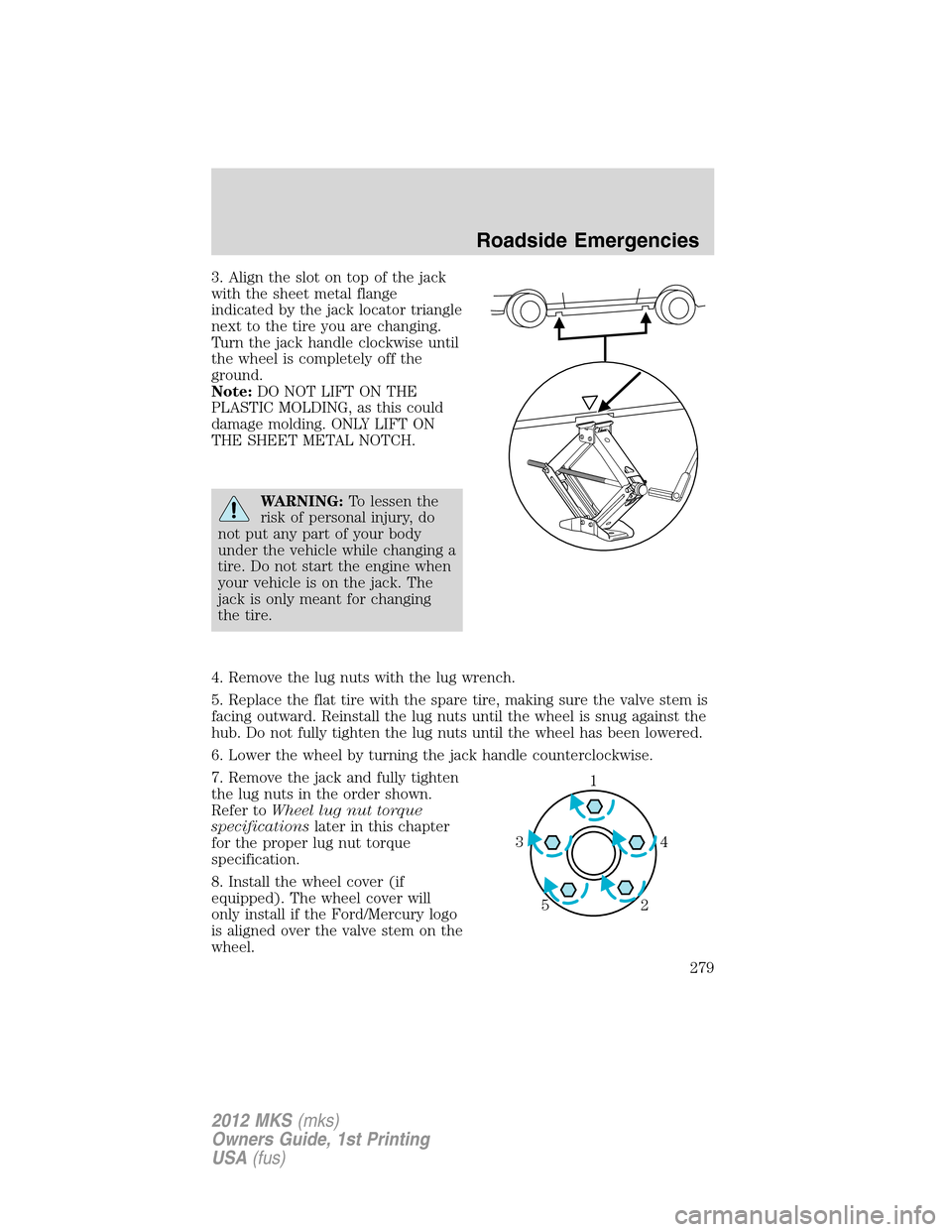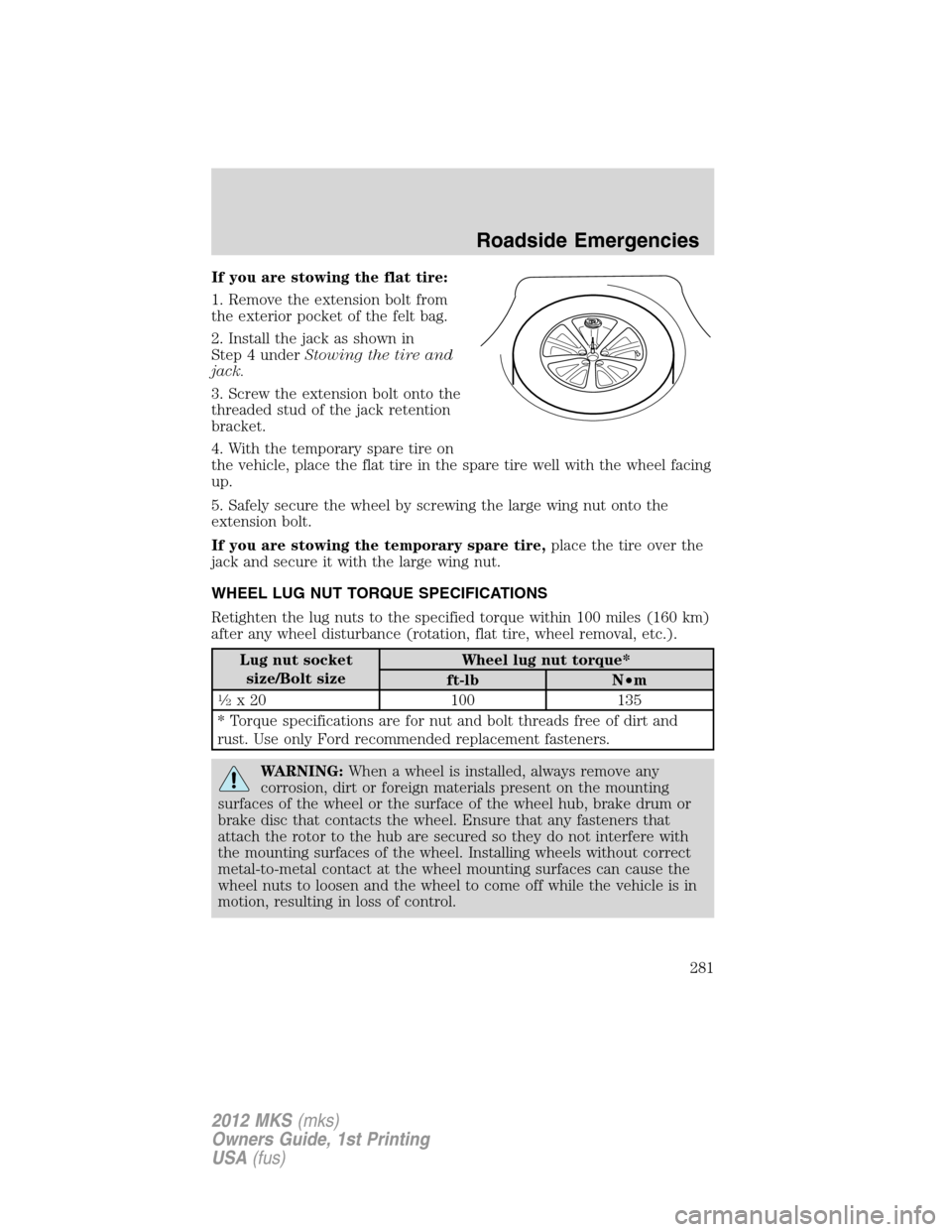Page 2 of 384
Seating and Safety Restraints 127
Seating 127
Personal Safety System™ 140
Safety belt system 143
Airbags 154
Child restraints 169
Tires, Wheels and Loading 186
Tire information 186
Tire inflation 188
Tire Pressure Monitoring System (TPMS) 201
Vehicle loading 206
Trailer towing 213
Recreational towing 216
Driving 218
Starting 218
Brakes 224
AdvanceTrac�227
Transmission operation 233
Forward and reverse sensing system 237
Rear-view camera system 240
All wheel drive 258
Roadside Emergencies 265
Getting roadside assistance 265
Hazard flasher control 266
Fuel pump shut-off 266
Fuses and relays 267
Changing tires 274
Wheel lug nut torque 281
Jump starting 282
Wrecker towing 286
Customer Assistance 288
Reporting safety defects (U.S. only) 296
Reporting safety defects (Canada only) 296
Table of Contents
2
2012 MKS(mks)
Owners Guide, 1st Printing
USA(fus)
Page 233 of 384

If the fuse is not blown and the brake lamps are working properly, you
will need to have your vehicle towed to an authorized dealer.
WARNING:Do not drive your vehicle until you verify that the
brake lamps are working.
WARNING:Always set the parking brake fully and make sure
the gearshift lever is latched in P (Park). Switch the ignition to
off and remove the key whenever you leave your vehicle.
WARNING:If the parking brake is fully released, but the brake
warning lamp remains illuminated, the brakes may not be
working properly. See your authorized dealer.
AUTOMATIC TRANSMISSION OPERATION
Understanding the gearshift positions of the 6–speed automatic
transmission
Your vehicle has been designed to improve fuel economy by reducing
fuel usage while coasting or decelerating. When you take your foot off
the accelerator pedal and the vehicle begins to slow down, the torque
converter clutch locks up and aggressively shuts off fuel flow to the
engine while decelerating. This fuel economy benefit may be perceived
as a light to medium braking sensation when removing your foot from
the accelerator pedal.
P (Park)
This position locks the transmission
and prevents the front wheels from
turning.
To put your vehicle in gear:
1. Press the brake pedal
2. Move the gearshift lever into the
desired gear
Driving
233
2012 MKS(mks)
Owners Guide, 1st Printing
USA(fus)
Page 258 of 384

Trailer tow false alerts
When towing a trailer, the sensors may detect the trailer thus causing a
false alert. It may be desirable to turn the BLIS�off if the false alerts
become annoying.
Day and night brightness
The BLIS�and/or CTA alert will automatically dim when the headlamp
switch is in PARK, ON, or AUTO ON and night time darkness has been
detected by the sun sensor.
ALL-WHEEL DRIVE (AWD) SYSTEM (IF EQUIPPED)
Your vehicle may be equipped with a full-time all-wheel drive (AWD)
system. The AWD system is an active system, meaning it not only
responds to wheel slip between the front and rear axles but also has the
ability to anticipate wheel slip and transfer torque to the rear wheels
before slip occurs. The AWD system is active all the time and requires no
input from the operator.
All components of the AWD system are sealed for life and require no
maintenance.
Note:When an AWD system fault is present, the warningCHECK AWD
will display in the message center. The AWD system is not functioning
correctly and defaulted to front-wheel drive. When this warning is
displayed, have your vehicle serviced at an authorized dealer.
If your vehicle is equipped with AWD, a spare tire of a different size
other than the tire provided should never be used. If the spare tire is
installed, the AWD system may disable automatically and enter
front-wheel drive only mode to protect driveline components. This
condition may be indicated by anAWD OFFmessage in the message
center (seeMessage centersection in theInstrument Clusterchapter
for more information). If there is anAWD OFFmessage in the message
center from using the spare tire, this indicator should turn off after
reinstalling the repaired or replaced normal road tire and driving a short
distance. It is recommended to reinstall the repaired or replaced road
tire as soon as possible. Major dissimilar tire sizes between the front and
rear axles could cause the AWD system to stop functioning and default
to front-wheel drive or damage the AWD system.
Note:TheAWD OFFmessage may also be displayed in the message
center if the AWD system has overheated and defaulted to front-wheel
drive. This condition may occur if the vehicle was operated in extreme
conditions with excessive wheel slip, such as deep sand. To resume
normal AWD function as soon as possible, stop the vehicle in a safe
Driving
258
2012 MKS(mks)
Owners Guide, 1st Printing
USA(fus)
Page 279 of 384

3. Align the slot on top of the jack
with the sheet metal flange
indicated by the jack locator triangle
next to the tire you are changing.
Turn the jack handle clockwise until
the wheel is completely off the
ground.
Note:DO NOT LIFT ON THE
PLASTIC MOLDING, as this could
damage molding. ONLY LIFT ON
THE SHEET METAL NOTCH.
WARNING:To lessen the
risk of personal injury, do
not put any part of your body
under the vehicle while changing a
tire. Do not start the engine when
your vehicle is on the jack. The
jack is only meant for changing
the tire.
4. Remove the lug nuts with the lug wrench.
5. Replace the flat tire with the spare tire, making sure the valve stem is
facing outward. Reinstall the lug nuts until the wheel is snug against the
hub. Do not fully tighten the lug nuts until the wheel has been lowered.
6. Lower the wheel by turning the jack handle counterclockwise.
7. Remove the jack and fully tighten
the lug nuts in the order shown.
Refer toWheel lug nut torque
specificationslater in this chapter
for the proper lug nut torque
specification.
8. Install the wheel cover (if
equipped). The wheel cover will
only install if the Ford/Mercury logo
is aligned over the valve stem on the
wheel.
1
4 3
2 5
Roadside Emergencies
279
2012 MKS(mks)
Owners Guide, 1st Printing
USA(fus)
Page 281 of 384

If you are stowing the flat tire:
1. Remove the extension bolt from
the exterior pocket of the felt bag.
2. Install the jack as shown in
Step 4 underStowing the tire and
jack.
3. Screw the extension bolt onto the
threaded stud of the jack retention
bracket.
4. With the temporary spare tire on
the vehicle, place the flat tire in the spare tire well with the wheel facing
up.
5. Safely secure the wheel by screwing the large wing nut onto the
extension bolt.
If you are stowing the temporary spare tire,place the tire over the
jack and secure it with the large wing nut.
WHEEL LUG NUT TORQUE SPECIFICATIONS
Retighten the lug nuts to the specified torque within 100 miles (160 km)
after any wheel disturbance (rotation, flat tire, wheel removal, etc.).
Lug nut socket
size/Bolt sizeWheel lug nut torque*
ft-lb N•m
1�2x 20 100 135
* Torque specifications are for nut and bolt threads free of dirt and
rust. Use only Ford recommended replacement fasteners.
WARNING:When a wheel is installed, always remove any
corrosion, dirt or foreign materials present on the mounting
surfaces of the wheel or the surface of the wheel hub, brake drum or
brake disc that contacts the wheel. Ensure that any fasteners that
attach the rotor to the hub are secured so they do not interfere with
the mounting surfaces of the wheel. Installing wheels without correct
metal-to-metal contact at the wheel mounting surfaces can cause the
wheel nuts to loosen and the wheel to come off while the vehicle is in
motion, resulting in loss of control.
Roadside Emergencies
281
2012 MKS(mks)
Owners Guide, 1st Printing
USA(fus)